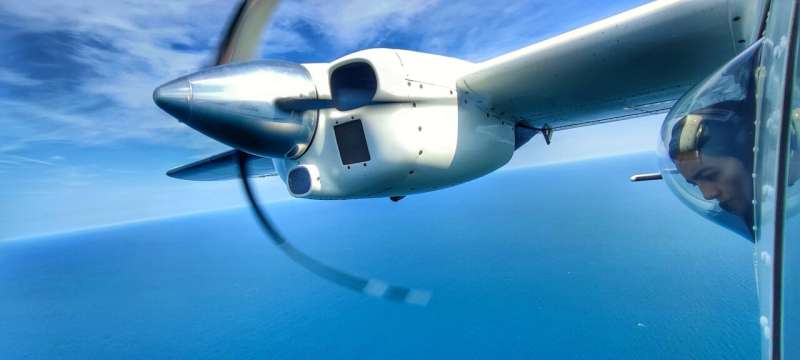This article has been reviewed according to Science X's editorial process and policies. Editors have highlighted the following attributes while ensuring the content's credibility:
fact-checked
proofread
New population numbers: 1.4 million whales, dolphins and porpoises in the European Atlantic

The large-scale international survey SCANS-IV has estimated there are more than 1.4 million whales, dolphins and porpoises in the European Atlantic.
This international research project, the results of which were presented at the ASCOBANS (Agreement on the Conservation of Small Cetaceans in the Baltic, North East Atlantic, Irish and North Seas) Advisory Committee meeting last week, was coordinated by Dr. Anita Gilles from the University of Veterinary Medicine Hannover in Germany.
The cetacean sighting survey (SCANS-IV) is the fourth in a series of surveys that began in 1994 (SCANS) and continued in 2005 (SCANS-II) and 2016 (SCANS-III) to determine the population size and distribution of cetaceans in European Atlantic waters.
Mobilizing eight small aircraft and one research vessel from southern Norway to Portugal, SCANS-IV surveyed the European Atlantic in summer 2022 with the largest amount of search effort to date.
The most abundant species were harbor porpoise (409,000), common dolphin (439,000) and striped dolphin (187,000), with a further 146,000 either common or striped dolphins. Numbers of other species of dolphins estimated to be present were 126,000 bottlenose dolphins, 67,000 white-beaked dolphins and 4,000 white-sided dolphins.
Deep-diving whales that feed primarily on squid in offshore waters were estimated to be 3,000 pilot whales, 148 sperm whales and 5,000 beaked whales of several different species. This is an overall lower estimate than in the surveys before but, especially for this species group, constitutes a minimum estimate and is not fully comparable because important habitats in offshore waters west of Scotland were not surveyed in SCANS-IV.
Of the filter-feeding baleen whales, 12,000 minke whales and 13,000 fin whales were estimated to be present.
The occurrence of common dolphin increased in the Celtic Sea, as well as southwest of the U.K. and in the western part of the English Channel, suggesting that northward population range expansion found in the previous SCANS surveys, continues.
A different picture emerged for the most abundant cetacean, the harbor porpoise: The results indicate that the shift seen in harbor porpoise distribution in the North Sea from the northwest in 1994 to the south in 2005 and 2016 was maintained in 2022, with the distribution expanding even further in the Channel. Highest densities were found in the central and southwestern North Sea.
For harbor porpoise, white-beaked dolphin and minke whale in the North Sea, the series of abundance estimates shows no significant change in abundance over the 28 years covered by the surveys. However, the harbor porpoise population in the western Baltic Sea, Belt Seas and the southern Kattegat shows signs of a decline. HELCOM, the Regional Sea Convention in the Baltic Sea, recently assessed this population as not in being in good status due to unsustainable levels of bycatch in fisheries highlighting a need for conservation measures and further exploration of the pressures on this population.
For the other populations and species in the survey region, the SCANS team is looking forward to integrating the outputs from its sister survey, the Irish ObSERVE program, when available to further develop the picture of what has changed in species abundance and distribution since the last surveys.
Dr. Gilles, who presented the results to the international audience, said, "The results from these large-scale international surveys in the last three decades have greatly expanded our knowledge of the distribution and abundance of cetacean species in European Atlantic waters, enabling fisheries bycatch and other anthropogenic stressors to be placed in a population context and giving a strong basis for assessments of conservation status. The information now available forms a good foundation for a large-scale time series continuing in the coming decades."
The survey was a collaboration among scientists in eight countries bordering the Atlantic, namely Denmark, Germany, France, Netherlands, Spain, Sweden, Portugal and the U.K., and was supported by the governments of those countries.
The surveys covered an area of 1.7 million square kilometers from the Strait of Gibraltar, Portugal, to southern Norway in the north in summer 2022. Teams of observers searched along 75,000 km of transect line, recording thousands of groups of cetaceans from 17 different species.
The SCANS project is internationally recognized for its excellence in data collection and analysis standards. It also exemplifies coordination between EU Member States and neighboring countries to implement joint cetacean monitoring programs.
The new estimates of abundance will be integral to assess the impact of bycatch and other increasing anthropogenic pressures on cetacean populations. Furthermore, SCANS facilitates the delivery of coherent and consistent assessments for cetacean populations, as required by the EU Marine Strategy Framework Directive (or equivalent) assessments of Good Environmental Status as well as by Regional Sea Conventions such as OSPAR and HELCOM.
Matthieu Authier and Mathieu Genu (both at La Rochelle University, France) said, "The new SCANS-IV results are invaluable to understand what's happening to cetaceans in the Northeast Atlantic today." Dr. Laran (also at La Rochelle University) concurred, "This survey delivers a comprehensive overview of the distribution of cetaceans which is crucial knowledge in our time of global changes."
Nikki Taylor from JNCC in the U.K. commented, "Whales, dolphins and porpoises are highly mobile, many of which have ranges that go far beyond that of any single country jurisdiction. Widescale collaborative surveys such as SCANS are essential as a tool to understand the abundance and distribution of these animals at scales relative to their movements, to enable effective status assessment and management decisions."
Steve Geelhoed (Wageningen Marine Research, the Netherlands) said, "This series of summer surveys is essential for the conservation of cetaceans, and we need to start collecting data on this large scale in other seasons as well."
Provided by Stiftung Tierärztliche Hochschule Hannover



















